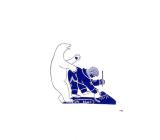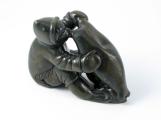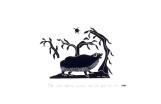2
Jobie Ohaituk [b. 1946]"The future of carving, in my opinion, and based on my thoughts on the next generation, is that they will show who we are, our 'Inuitness.' They exist for this reason. [The carvings] show the ability of Inuit. They also show what it was like in the past, our legends, what it was like in the old days, and who our forefathers were. My children will know me through the carvings I have made, and those who buy them will know who I am." (La Fédération Coopératives du Nouveau-Québec 2009)
"Our way of living has changed, but when our youth see carvings depicting the old ways, they know that we aren't just making up stories. How we carve should not disappear. I'm happy that I'm helping preserve our culture through my carving." (Inuit Art Quarterly (IAQ) 1998)
His story
Jobie Ohaituk was born in Kutaaq, north of present-day Inukjuak in 1946. It was in 1956, when he was only ten-years-old, that he first realized he could make a living by carving. "I was young and it was difficult. I remember holding onto the heavy stone and trying to figure out what I was going to make with it. I made what I was comfortable with - a bird. I've never forgotten it or the stone. It was a good stone, green and red. I sold my first carving to the Hudson's Bay Company. I was given a pair of mitts for it, although I was hoping I'd get candy. My mother had told me that I couldn't even do the finishing sanding on a carving because I was too young. But I have been carving ever since, and, when I'm not carving, I'm out hunting. My life hasn't changed in all these years," he said during an interview with Inuit Art Quarterly (IAQ) in 1998. Although he had been carving for many years, it wasn't until the early 1990s that he made a decision to devote most of his time to making art. "I realized at the time that I needed to improve my work. I began taking even more care in my sculpting, increasing my enthusiasm for it. It was a bit like starting over again" (La Fédération Coopératives du Nouveau-Québec website www.artnunavik.ca, accessed 29 September 2008). He produced a number of prints including a self portrait, while the Inukjuak print shop was in operation during the 1970s.
His art
Jobie Ohaituk chooses beautiful stone to carve with, although he says obtaining the stone is a painstaking process. "Quarrying stone is hard work... It slows you down a lot. You have to use a hammer and an axe and then a shovel to get the chunks of rock out of the ground. After you get the stone, you have to think about what you're going to do with it, what the movement is going to be, what the meaning is. That is hard. It is difficult when you are trying to make something with meaning and life... You can take pictures with a camera and try to carve from that, but it's hard to put it into stone" (Inuit Art Quarterly [IAQ] 1998). He chooses to work only with hand tools since, he says, power tools make him lose touch with the stone. He begins carving by sawing off the excess stone, then chipping away at it with an axe until the shape resembles the idea he has in his mind. Towards the end, he makes the surface smooth with sandpaper and meticulously adds details. "Sometimes, when you look at a piece of stone, it already has a shape." His sculptures consist largely of narrative scenes.
His achievements
Jobie Ohaituk is one of the better known carvers in Nunavik. His work has been purchased by the Canadian Guild of Crafts in Montreal, the Canadian Museum of Civilization, and the University of Lethbridge Art Gallery. In 2001, Bombardier presented one of his carvings entitled Father and Son Fishing to U.S. President George W. Bush.
References
La Fédération Coopératives du Nouveau-Québec (FCNQ)
Jobie Uqaituk : Biographies/Career/Interview.
Inuit Art Quarterly (IAQ)
1998 "Jobie Ohaituq: 'Carving is not just for recreation'," vol. 13, no. 3 (fall):40.
3
"A Man Confronted by a Polar Bear While He Was Hitting a Seal with a Stick" by Jobie Ohaituq1974
Inukjuak, Quebec, Canada

8
"Blowing up the Avataq Float" by Jobie Ohaituk2007
Inukjuak, Quebec, Canada
 Credits:
Credits:La Fédération Coopératives du Nouveau-Québec
Photo: Bernard Murdoch
9
"Woman Fishing" by Jobie Ohaituk2008
Inukjuak
 Credits:
Credits:La Fédération Coopératives du Nouveau-Québec
Photo: Bernard Murdoch
10
"Man with Fish" by Jobie Ohaituk2008
Inukjuak, Quebec, Canada
 Credits:
Credits:La Fédération Coopératives du Nouveau-Québec
Photo: Bernard Murdoch




